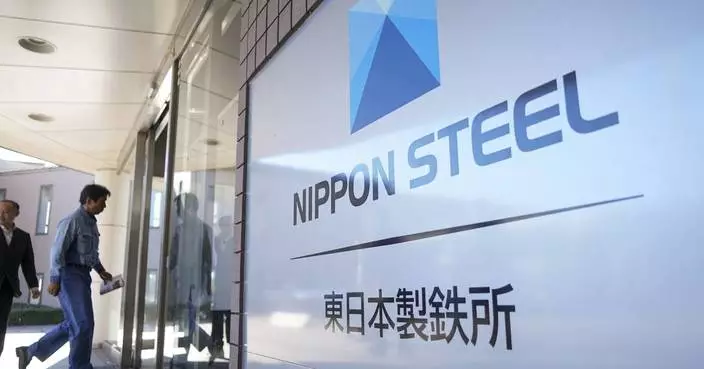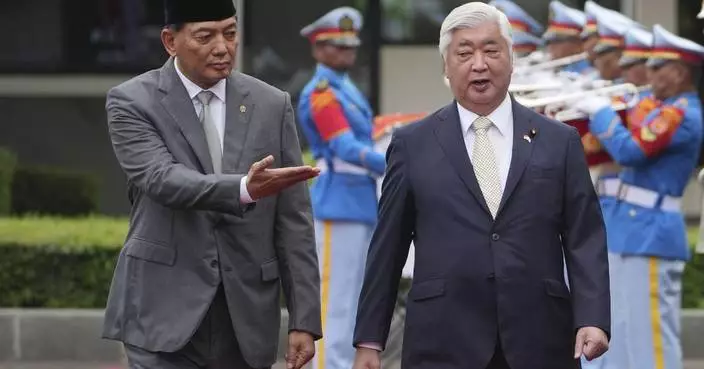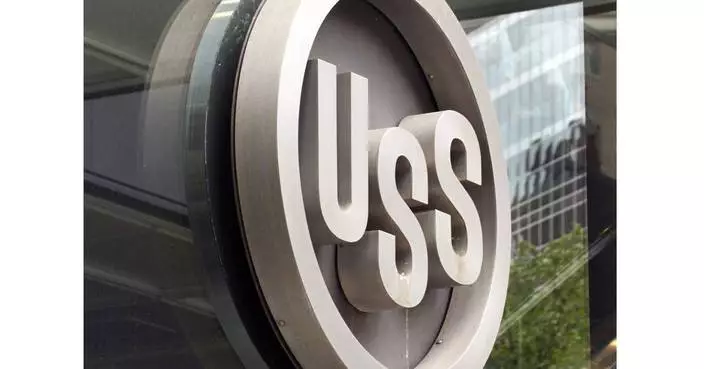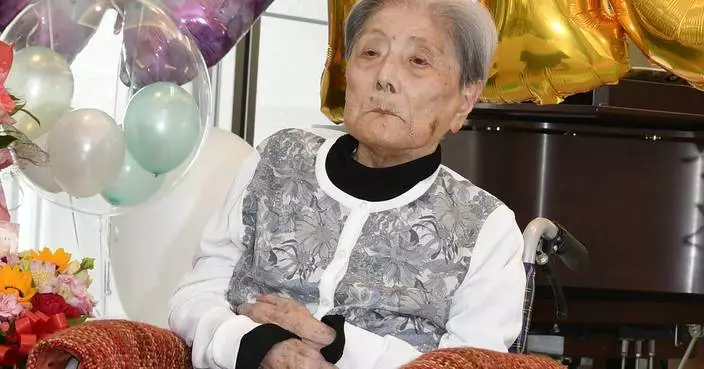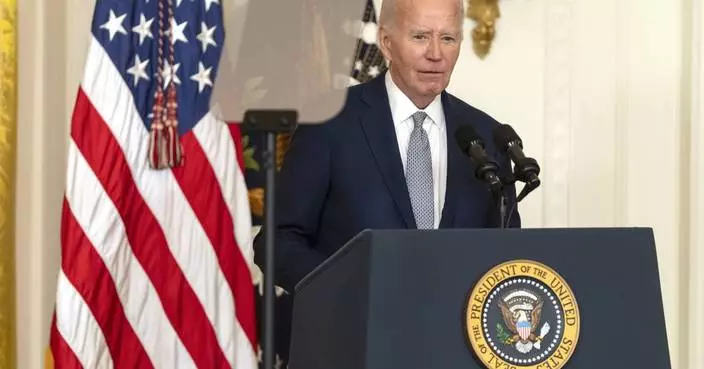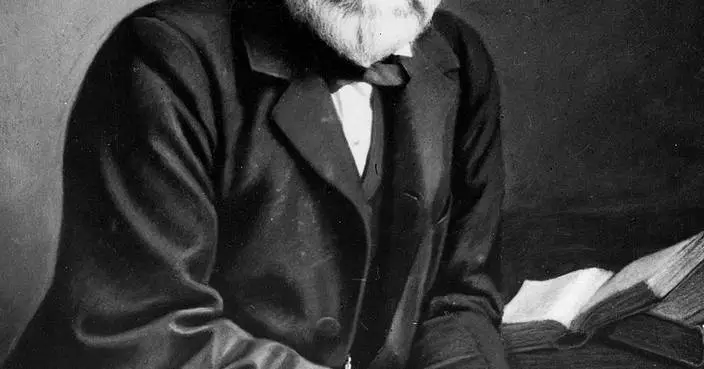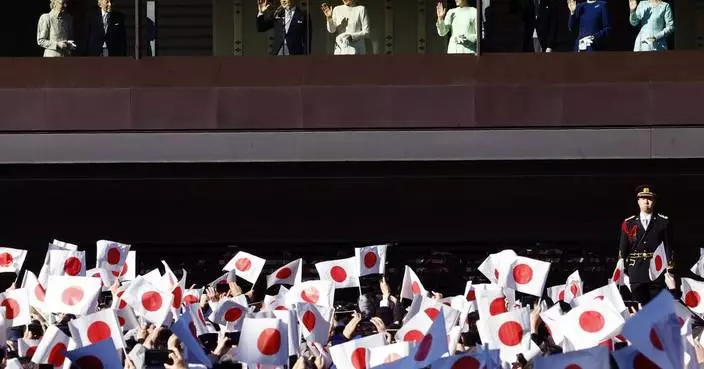The executions Friday of a doomsday cult leader and six of his followers closed a chapter on one of Japan's most shocking crimes, the poison gas attack on rush-hour commuters in Tokyo's subway that killed 13 people and sickened more than 6,000.
The attack in 1995 woke up a relatively safe country to the risk of urban terrorism. The ensuing raid on the cult's compound near Mount Fuji riveted Japan, as 2,000 police officers approached with a canary in a bird cage. Shoko Asahara, the bearded, self-proclaimed guru who had recruited scientists and others to his cult, was found two months later, hiding in a compartment in a building ceiling.
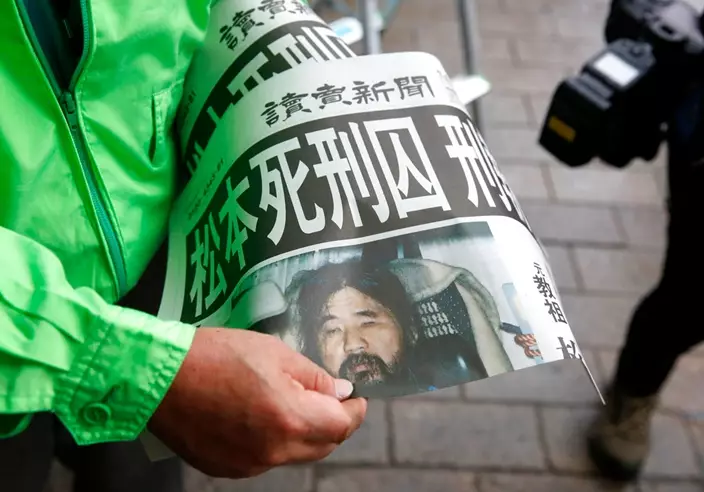
A staff of Japanese newspaper Yomiuri Shimbun distributes their extra edition reporting doomsday cult leader Shoko Asahara was executed, in Tokyo Friday, July 6, 2018. Asahara and six followers were executed Friday for their roles in a deadly 1995 gas attack on the Tokyo subways and other crimes, Japan's Justice Ministry said. (AP Photo/Shuji Kajiyama)
The executions of the 63-year-old Asahara and the six cult members were announced by the Justice Ministry after they had been hanged, as is the practice in Japan. Two major newspapers issued extra editions and handed them out at train stations.
"This gave me peace of mind," Kiyoe Iwata, who lost her daughter in the subway attack, told broadcaster NHK. "I have always been wondering why it had to be my daughter and why she had to be killed. Now, I can pay a visit to her grave and tell her of this."
The executions were a long time coming, but they were expected as the last trial in the case had been completed and some of the condemned convicts had been transferred to other prisons earlier this year. Six other cult members remain on death row.
The subway attack was the most notorious of the cult's crimes, which was blamed for 27 deaths in all. Named Aum Shinrikyo, or Supreme Truth, it amassed an arsenal of chemical, biological and conventional weapons to carry out Asahara's escalating criminal orders in anticipation of an apocalyptic showdown with the government.
Japan's justice minister, who approved the hangings Tuesday, said she doesn't take executions lightly but felt these were justified because of the unprecedented seriousness of the crimes the seven committed.
"The fear, pain and sorrow of the victims, survivors and their families — because of the heinous cult crimes — must have been so severe, and that is beyond my imagination," Justice Minister Yoko Kamikawa told a news conference.
She said the crime affected not only Japan but also sowed fear abroad.
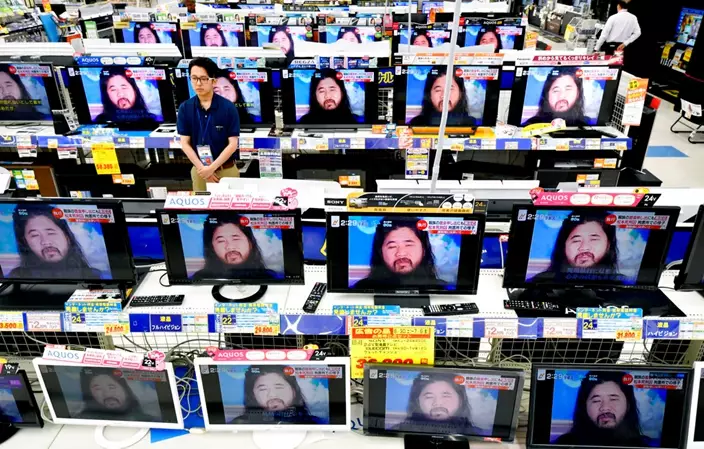
TV screens at an electrical appliance store show the image of doomsday cult leader Shoko Asahara in news reports, in Urayasu, near Tokyo, Friday, July 6, 2018. Asahara and six followers were executed Friday for their roles in a deadly 1995 gas attack on the Tokyo subways and other crimes, Japan’s Justice Ministry said. (Kyodo News via AP)
The seven executions in one day were the most since Japan began releasing information on executions in 1998. They were hanged in detention centers in Tokyo and three other places, spread out so the executions could be done at once.
Japan hangs several people in an average year but keeps the executions highly secretive. The country started disclosing the names of the executed and their locations only 11 years ago. Those executed learn their fate only when they are taken to the gallows. There are 117 convicts on death row.
Six of the seven, including Asahara, had been implicated in the subway attack. They included three scientists who led the production of the sarin gas and a man who drove a getaway vehicle.
Their other crimes include the 1989 murders of an anti-Aum lawyer and his wife and 1-year-old baby and a 1994 sarin attack in the city of Matsumoto in central Japan, which killed seven people and injured more than 140. An eighth person died after being in a coma for a decade.
On March 20, 1995, cult members used umbrellas to puncture plastic bags, releasing sarin nerve gas inside subway cars just as their trains approached the Kasumigaseki station, Japan's Capitol Hill, during the morning rush. Commuters poured out of subway stations in downtown Tokyo, and the streets were soon filled with troops in Hazmat suits and people being treated in first-aid tents set up outside.
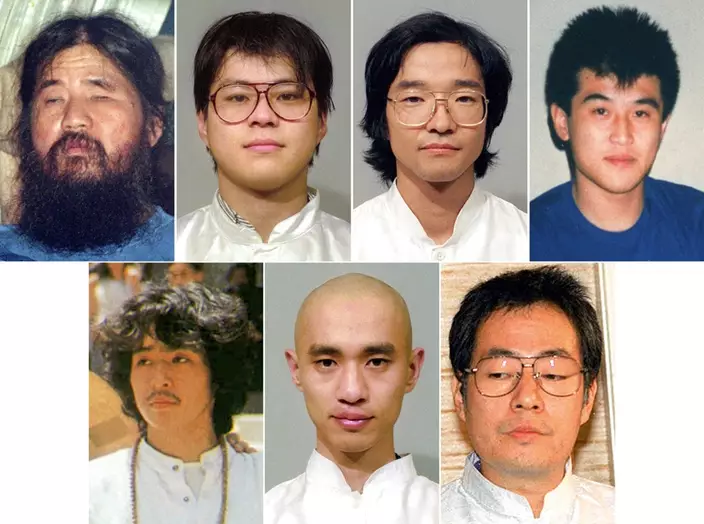
FILE - This combination of file photos shows Aum Shinrikyo cult leader Shoko Asahara, from top left to right, his cult members, Tomomasa Nakagawa, Seiichi Endo, and Masami Tsuchiya. Other members from bottom left to right, Yoshihiro Inoue, Tomomitsu Nimi, and Kiyohide Hayakawa. Japan executed the leader and six followers of a doomsday cult Friday, July 6, 2018, for a series of deadly crimes including a sarin gas attack on the Tokyo subway that killed 13 people in 1995. (Kyodo News via AP, File)
The convicted also assaulted and murdered wayward followers and people who helped members leave the cult.
Asahara, whose original name was Chizuo Matsumoto, founded Aum Shinrikyo in 1984. The cult attracted many young people, including graduates of top universities.
During his eight-year trial, Asahara talked incoherently, occasionally babbling in broken English, and never acknowledged his responsibility or offered meaningful explanations.
He was on death row for about 14 years. His family has said he was a broken man, constantly wetting and soiling the floor of his prison cell and not communicating with his family or lawyers. They had requested his mental treatment a retrial.
Some survivors of the cult's crimes opposed the executions, saying they would end hopes for a fuller explanation of the crimes.
Shizue Takahashi, whose husband was a subway deputy station master who died in the attack, also expressed regret that six of Asahara's followers had been killed.
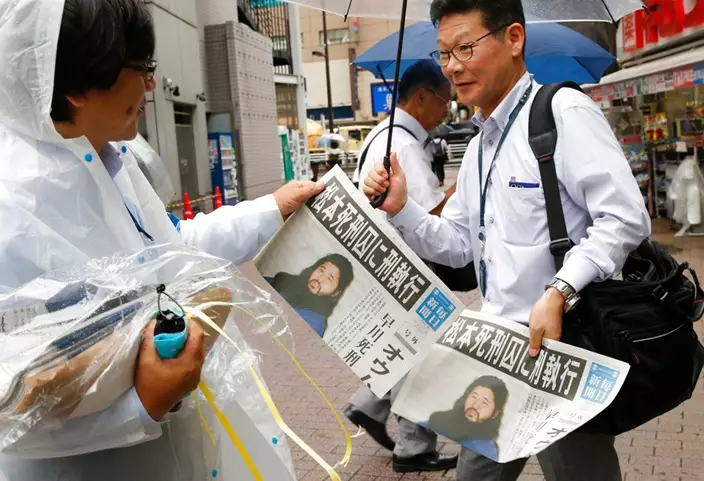
A staff of Japanese newspaper Mainichi Shimbun distributes their extra edition reporting that doomsday cult leader Shoko Asahara was executed, in Tokyo Friday, July 6, 2018. Asahara and six followers were executed Friday for their roles in a deadly 1995 gas attack on the Tokyo subways and other crimes, Japan's Justice Ministry said. (AP Photo/Shuji Kajiyama)
"I wanted the others to talk more about what they did as lessons for anti-terrorism measures in this country, and I wanted the authorities and experts to learn more from them," she told a televised news conference. "I regret that is no longer possible."
The cult claimed 10,000 members in Japan and 30,000 in Russia. It has disbanded, though nearly 2,000 people follow its rituals in three splinter groups, monitored by authorities.
Chief Cabinet Secretary Yoshihide Suga said authorities are taking precautionary measures in case of any retaliation by his followers.
WASHINGTON (AP) — Nearly 44 years after Jimmy Carter left the nation's capital in humbling defeat, the 39th president returned to Washington on Tuesday for state funeral rites that featured the kind of bipartisan praise and ceremonial pomp the Georgia Democrat rarely enjoyed at his political peak.
The military honor guards, a procession down Pennsylvania Avenue and a service in the Capitol Rotunda continued public commemorations for Carter, who died Dec. 29 at age 100. Services will continue through his state funeral Thursday at the National Cathedral, before Carter returns to his hometown of Plains, Georgia, for burial beside his late wife, former first lady Rosalynn Carter, who died in 2023.
As the sun set outside the Capitol, Vice President Kamala Harris, House Speaker Mike Johnson and Senate Majority Leader John Thune — none of whom were old enough to vote in Carter's two national campaigns — celebrated his faith, military service and devotion to service more than anything he did in politics.
“To be sure, his presidency was not without its challenges and international crises,” said Harris, for whom Carter cast his final presidential ballot this fall. But she described him nonetheless as “that all-too-rare example of a gifted man who also walks with humility, modesty and grace.”
As a presidential candidate in 1976, Harris noted, he slept in the homes of his supporters to “share a meal with them at their table and listen to what was on their minds.”
Thune, the newly elected majority leader, ticked through Carter's legacy beyond the White House, including his hands-on contributions to rebuilding homes through Habitat For Humanity. “First and foremost a faithful servant of his creator, and his fellow man,” said Thune, a South Dakota Republican.
Johnson, a Louisiana Republican who was just four years old when Carter was inaugurated, recalled his fellow Southerner as a man “willing to roll up his own sleeves to get the work done.”
The former president will lie in state Tuesday night and again Wednesday before his remains are moved to National Cathedral. There, President Joe Biden will eulogize Carter.
Carter’s remains, which had been lying in repose at the Carter Presidential Center since Saturday, left the Atlanta campus Tuesday morning, accompanied by his children and extended family. Special Air Mission 39 departed Dobbins Air Reserve Base north of Atlanta and arrived at Joint Base Andrews in Maryland before Carter was brought to Washington.
Carter never traveled as president on the iconic blue and white Boeing 747 variant that is known as Air Force One when the sitting president is on board. It first flew as Air Force One in 1990 with President George H.W. Bush.
Many of the rituals this week are typical of what follows a president’s death — the Air Force rides to and from the Beltway, the horse-drawn caisson in the capital, the Lincoln catafalque in the rotunda.
There also is symbolism unique to Carter. As he was carried from his presidential center, a military band played the hymns “Amazing Grace” and “Blessed Assurance” for the outspoken Baptist evangelical, who called himself a born-again Christian.
Another hymn, “Just as I am, without one plea,” played as Carter was transferred from the hearse at the U.S. Navy Memorial to the horse-drawn caisson for the rest of his trip to the Capitol. The location was a nod to Carter’s place as the lone U.S. Naval Academy graduate to become commander in chief.
The path also was meant as a mirror to Carter famously getting out of his secure limousine during the 1977 inaugural parade and walking up Pennsylvania Avenue to the White House with his family.
A bipartisan delegation of members of Congress were led into the Capitol Rotunda by Sens. Raphael Warnock and Jon Ossoff, both Democrats who represent Carter’s home state. Harris, members of President Joe Biden's cabinet and U.S. Supreme Court justices John Roberts, Brett Kavanaugh and Elena Kagan were present.
The U.S. Army Band Brass Quintet played as people awaited the casket. The room fell silent as three knocks on the rotunda door marked Carter's arrival. The casket was placed in the middle of the room on the catafalque built in 1865 to hold assassinated President Abraham Lincoln's casket in the same place.
The U.S. Naval Academy Glee Club performed “My Country, 'Tis of Thee” before congressional leaders and Harris, accompanied by her husband Doug Emhoff, placed wreaths beside the casket. Members of Carter's family, including some of his grandchildren and great-grandchildren, wiped tears.
The pomp carried some irony for a politician who went from his family peanut warehouse to the Governor’s Mansion and eventually the White House. Carter won the presidency as the smiling Southerner and technocratic engineer who promised to change the ways of Washington — and eschewed many of its unwritten rules when he got there.
From 1977 to 1981, Carter was Washington's highest-ranking resident. But he never mastered it.
“He could be prickly and a not very appealing personality” in a town that thrives on relationships, said biographer Jonathan Alter, describing a president who struggled with schmoozing lawmakers and reporters.
Carter often flouted the kind of ceremonial trappings that have been on display following his death.
While in office he wanted to keep the Marine Band from playing “Hail to the Chief,” thinking it elevated the president too much, but his advisers persuaded him to accept it as part of the job. It has played multiple times since Carter's presidential funeral ceremonies began.
He also never used his full name, James Earl Carter Jr., even when taking the oath of office. His full name was printed on memorial cards given to mourners in Atlanta and was used again in the rotunda.
Carter once addressed the nation from the White House residence wearing a cardigan, now on display at his museum and library. His remains now rest in a wooden casket that was carried and guarded by military pallbearers in impeccable dress uniforms, similar to the attire worn by the Naval Academy midshipmen who saluted him on Pennsylvania Avenue.
Still, Carter was not met entirely with adulation Tuesday. President-elect Donald Trump, who mocked Carter during the 2024 campaign, criticized him again during a news conference in Florida for ceding control of the Panama Canal.
Pressed on whether criticism of Carter was appropriate during the solemn national rites, Trump responded, “I liked him as a man. I disagreed with his policies. He thought giving away the Panama Canal was a good thing.”
“I didn’t want to bring up the Panama Canal because of Jimmy Carter’s death,” Trump added, though he had first mentioned it unprompted.
Trump plans to attend Carter's Washington funeral.
This story has been updated to correct the spelling of the last name of Sen. Jon Ossoff, not Osoff.
Cooper reported from Phoenix.
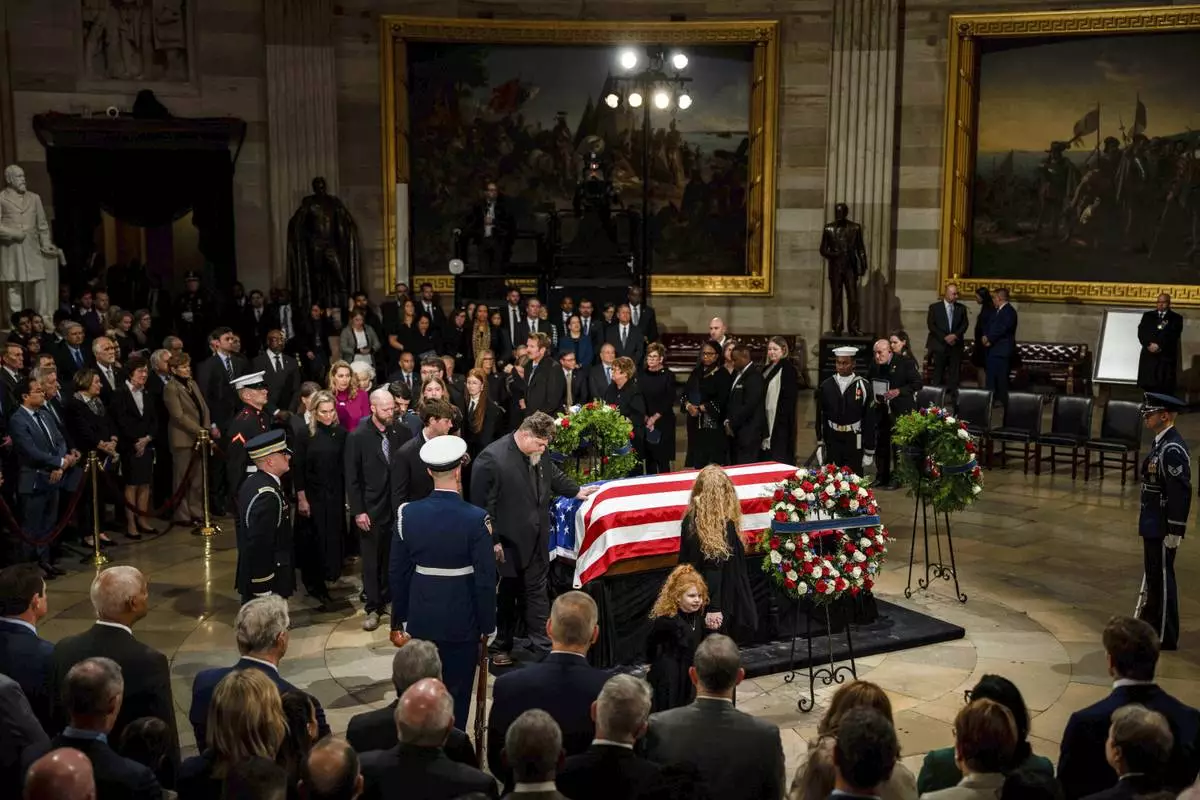
The Carter family pay their respects during a ceremony as the flag-draped casket of former President Jimmy Carter lies in state, at the Capitol, Tuesday, Jan. 7, 2025, in Washington. Carter died Dec. 29 at the age of 100. (Kent Nishimura/The New York Times via AP, Pool)
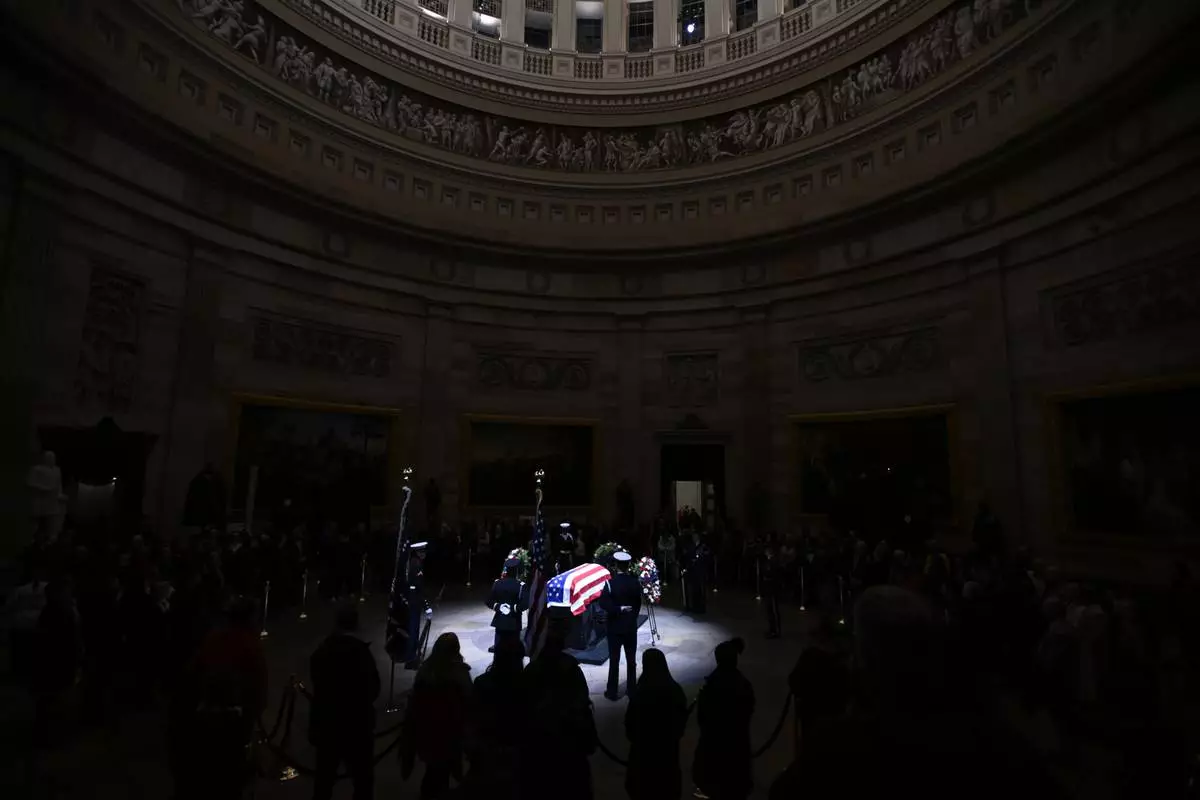
A spotlight iluminates the flag-draped casket to pay tribute toformer President Jimmy Carter as he lies in state at the Rotunda of the U.S. Capitol on Tuesday, Jan. 7, 2025, in Washington. (AP Photo/John McDonnell)
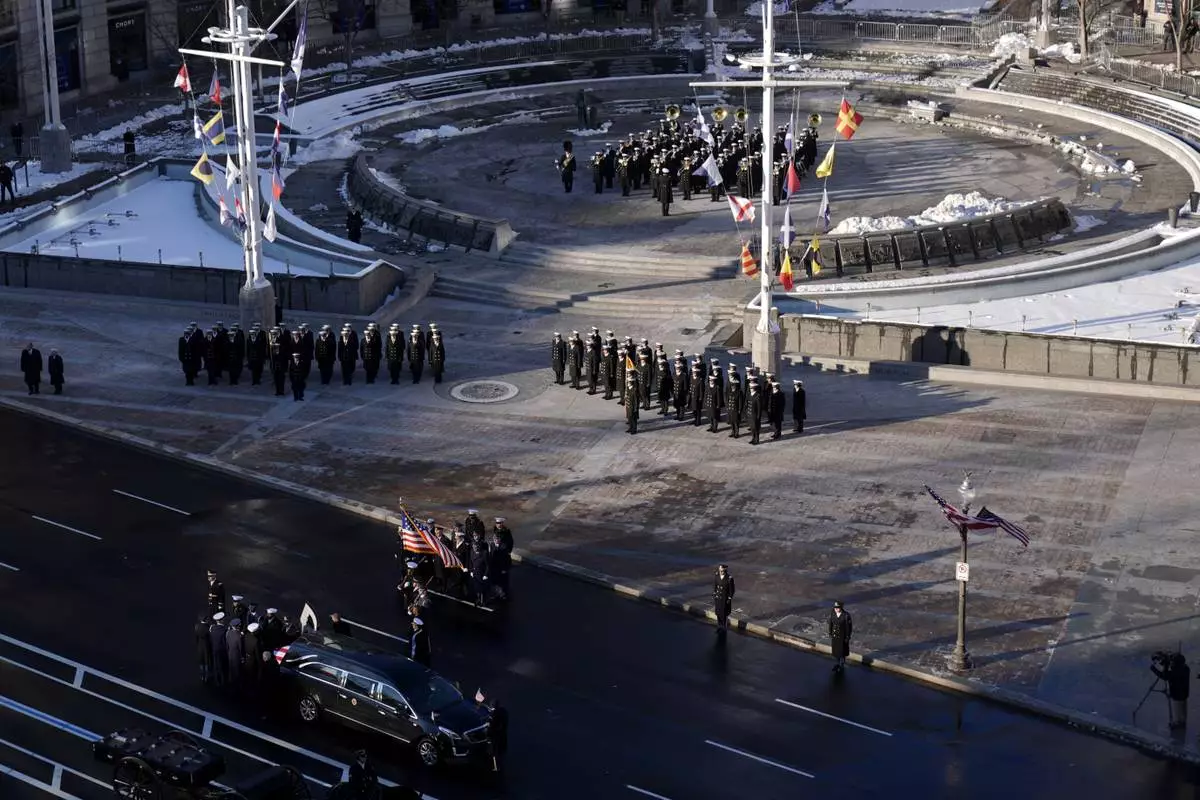
The flag-draped casket of former President Jimmy Carter is transferred to a horse-drawn caisson at the U.S. Navy Memorial before traveling on to the Capitol in Washington, Tuesday, Jan. 7, 2025, where Carter will lie in state. Carter died Dec. 29 at the age of 100. (AP Photo/Mark Schiefelbein, Pool)

A joint services military body bearer team carries the flag-draped casket of former President Jimmy Carter up the steps into the U.S Capitol, Tuesday, Jan. 7, 2025, in Washington. Carter died Dec. 29 at the age of 100. (Evelyn Hockstein/Pool via AP)

The flag-draped casket of former President Jimmy Carter lies in state at the rotunda of the U.S. Capitol Tuesday, Jan. 7, 2025, in Washington. (Andrew Harnik/Pool via AP)

The Carter family pay their respects during a ceremony as the flag-draped casket of former President Jimmy Carter lies in state, at the Capitol, Tuesday, Jan. 7, 2025, in Washington. Carter died Dec. 29 at the age of 100. (Kent Nishimura/The New York Times via AP, Pool)

Members of the public view the flag-draped casket of former President Jimmy Carter as it lies in state in the Rotunda, at the Capitol in Washington, Tuesday, Jan. 7, 2025. (AP Photo/Ben Curtis)
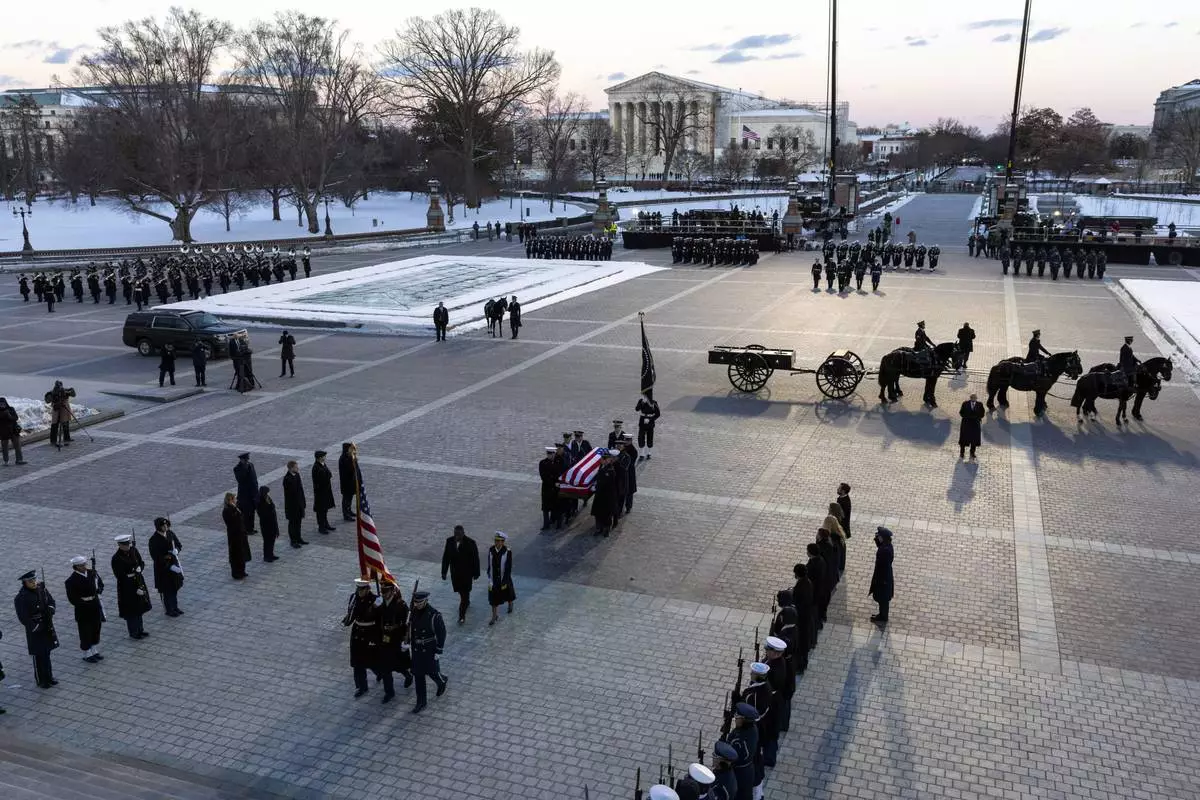
A joint services body bearer team moves the casket of former President Jimmy Carter after it arrived on a horse-drawn caisson at the East Front of U.S. Capitol in Washington, Tuesday, Jan. 7, 2025. (Shawn Thew/Pool via AP)
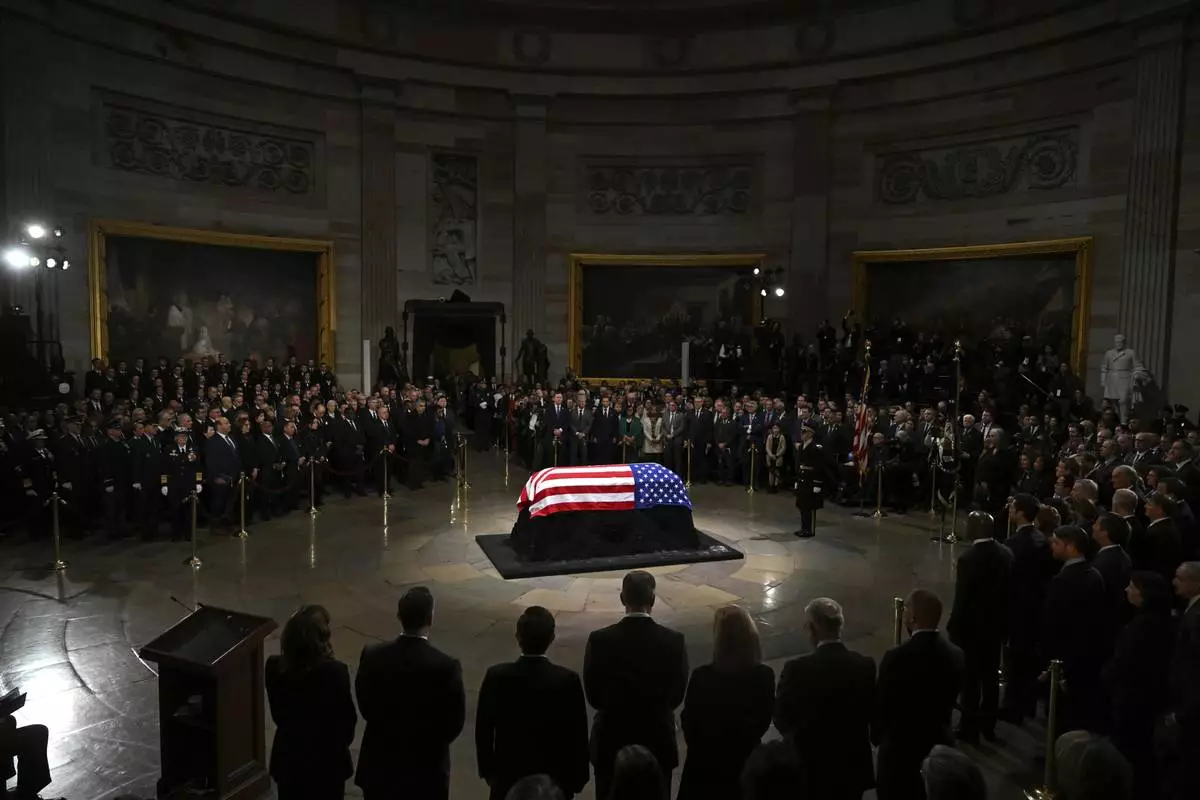
The flag-draped casket of former President Jimmy Carter lies in state during a ceremony in the Capitol, Tuesday, Jan. 7, 2025, in Washington. Carter died Dec. 29 at the age of 100. (Saul Loeb/Pool via AP)
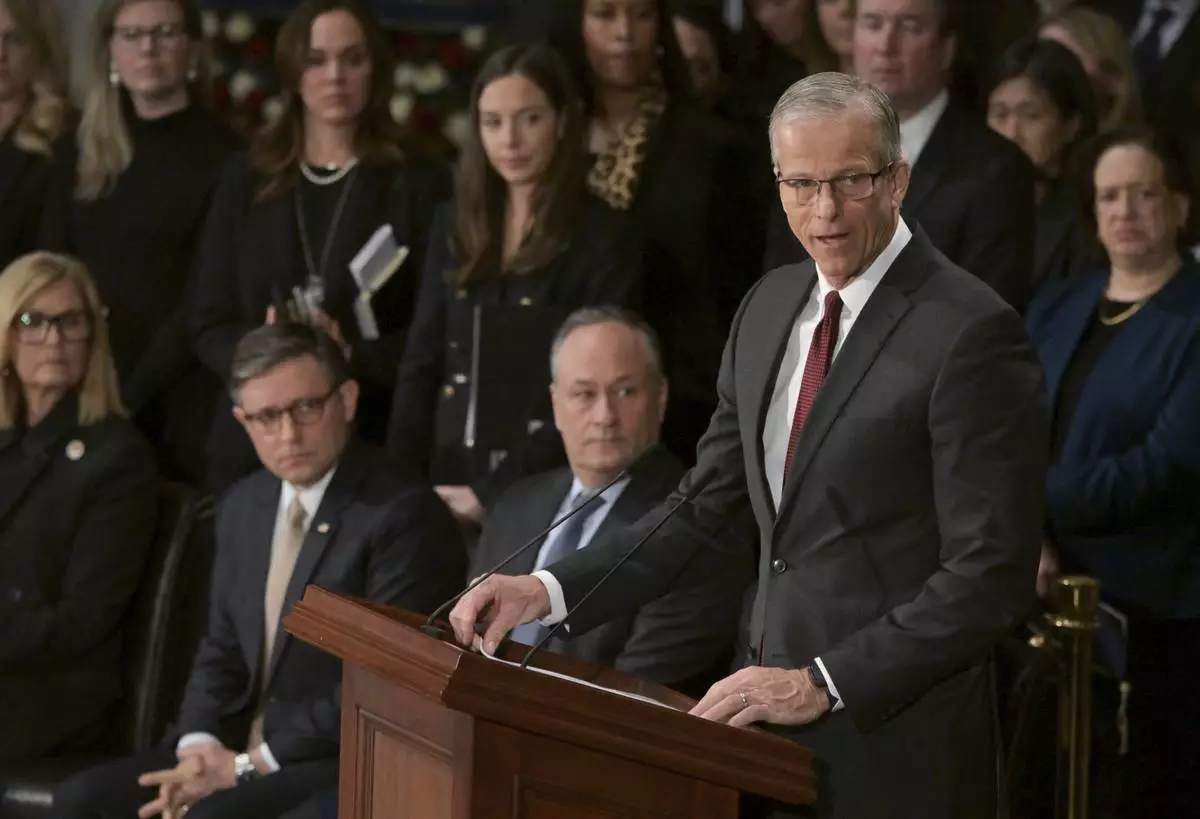
Senate Majority Leader John Thune delivers a eulogy for former President Jimmy Carter as he lies in state during a ceremony in the Capitol, Tuesday, Jan. 7, 2025, in Washington. Carter died Dec. 29 at the age of 100. (Ricky Carioti/The Washington Post via AP, Pool)

Speaker of the House Mike Johnson delivers a eulogy for former President Jimmy Carter as he lies in state during a ceremony in the Capitol, Tuesday, Jan. 7, 2025, in Washington. Carter died Dec. 29 at the age of 100. (Ricky Carioti/The Washington Post via AP, Pool)

Second gentleman Doug Emhoff, from left, and Vice President Kamala Harris place a wreath at the flag-draped casket of former President Jimmy Carter during a ceremony where Carter lies in state at the Capitol in Washington, Tuesday, Jan. 7, 2025. Carter died Dec. 29 at the age of 100. (AP Photo/J. Scott Applewhite, Pool)
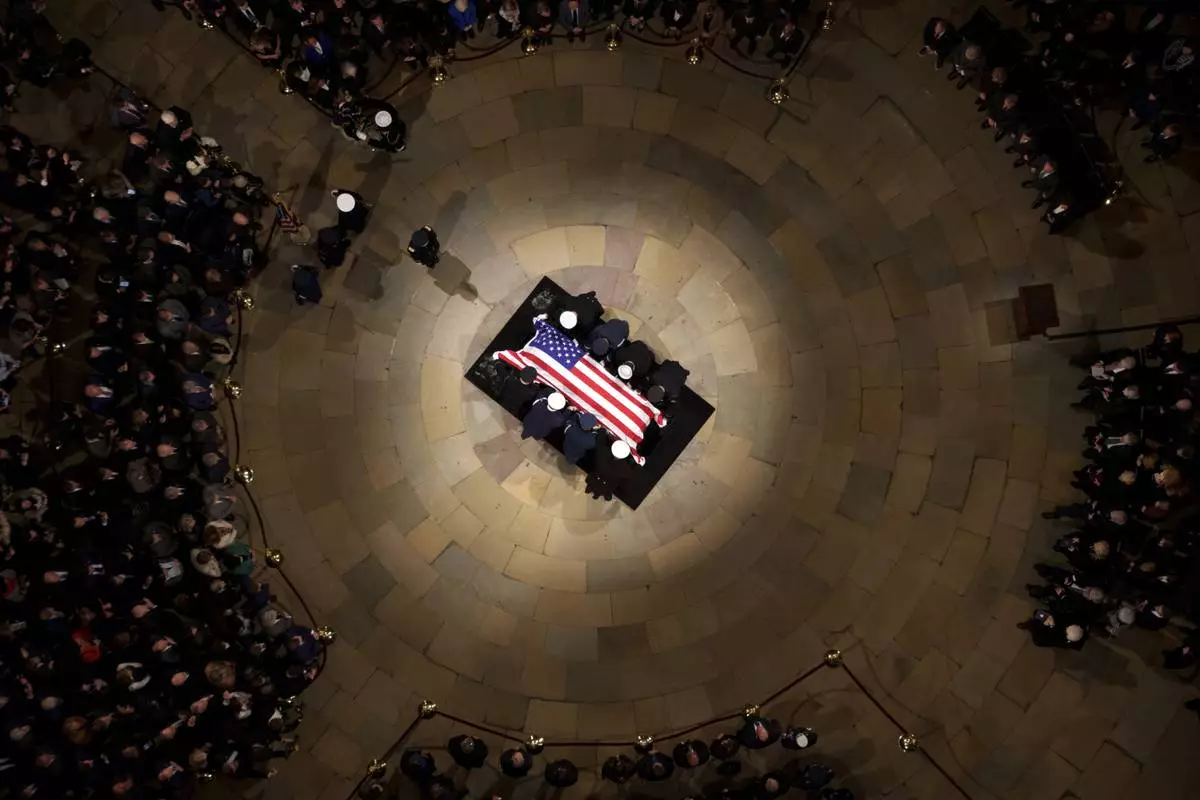
The flag-draped casket of former President Jimmy Carter lies in state at the rotunda of the U.S. Capitol Tuesday, Jan. 7, 2025, in Washington. (Andrew Harnik/Pool via AP)
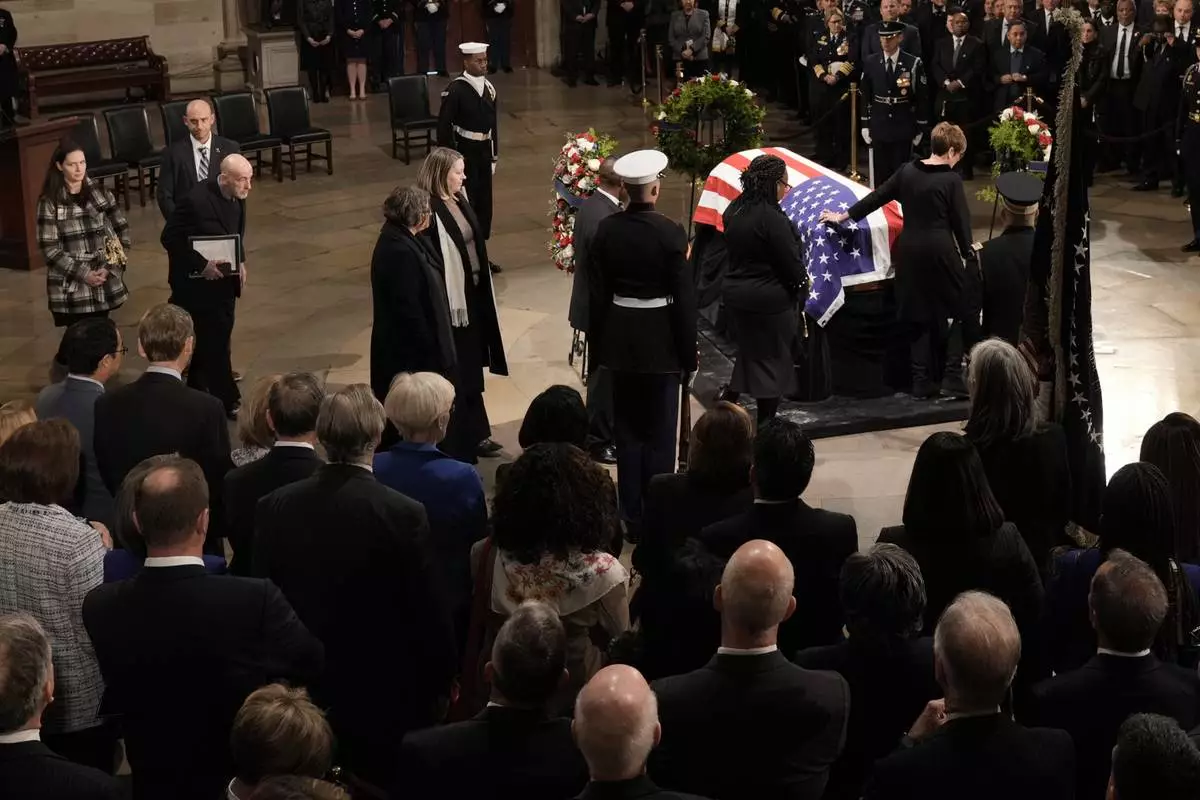
Members of the Carter family pay their respects as the flag-draped casket of former President Jimmy Carter lies in state at the U.S. Capitol, Tuesday, Jan. 7, 2025, in Washington. Carter died Dec. 29 at the age of 100. (AP Photo/J. Scott Applewhite, Pool)
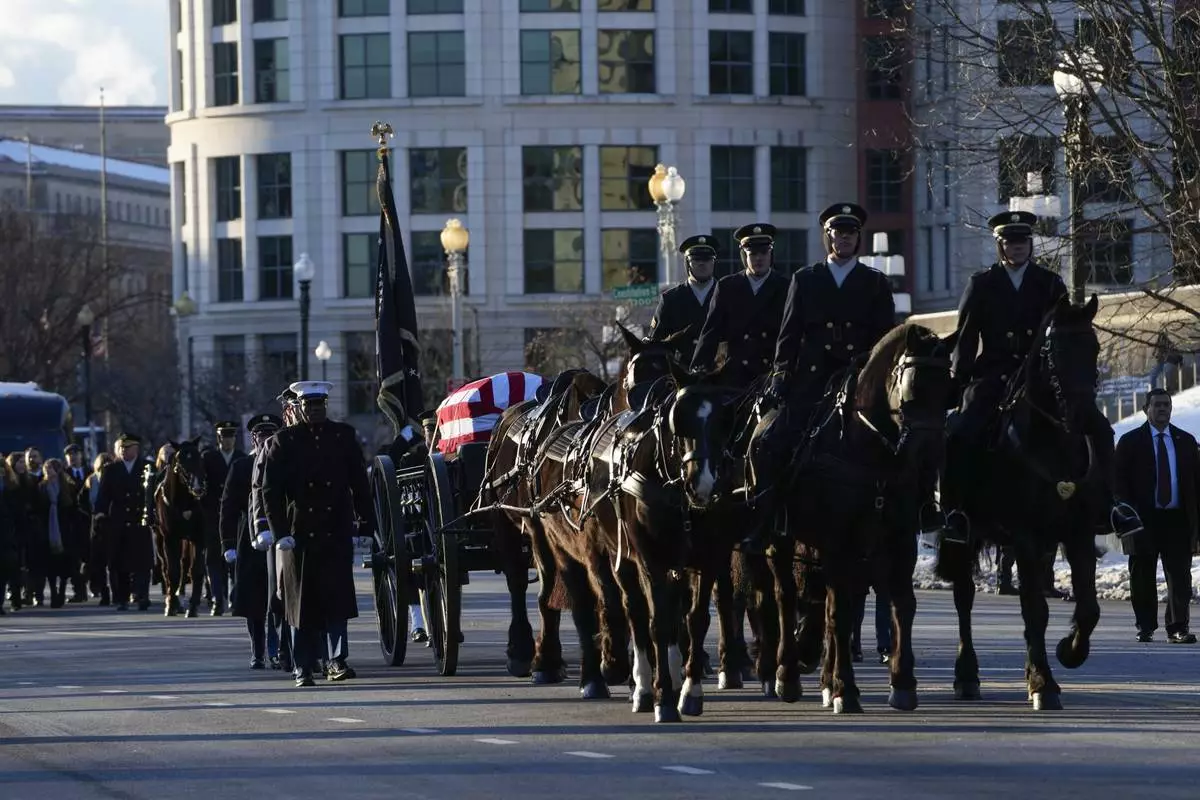
The casket containing the remains of former President Jimmy Carter moves on Constitution Avenue toward the U.S. Capitol on a horse-drawn caisson in Washington, Tuesday, Jan. 7, 2025. Carter died Dec. 29, 2024, at the age of 100. (AP Photo/Susan Walsh, Pool)

The flag-draped casket of former President Jimmy Carter is transferred to a horse-drawn caisson at the U.S. Navy Memorial before traveling on to the Capitol in Washington, Tuesday, Jan. 7, 2025, where Carter will lie in state. Carter died Dec. 29 at the age of 100. (AP Photo/Mark Schiefelbein, Pool)
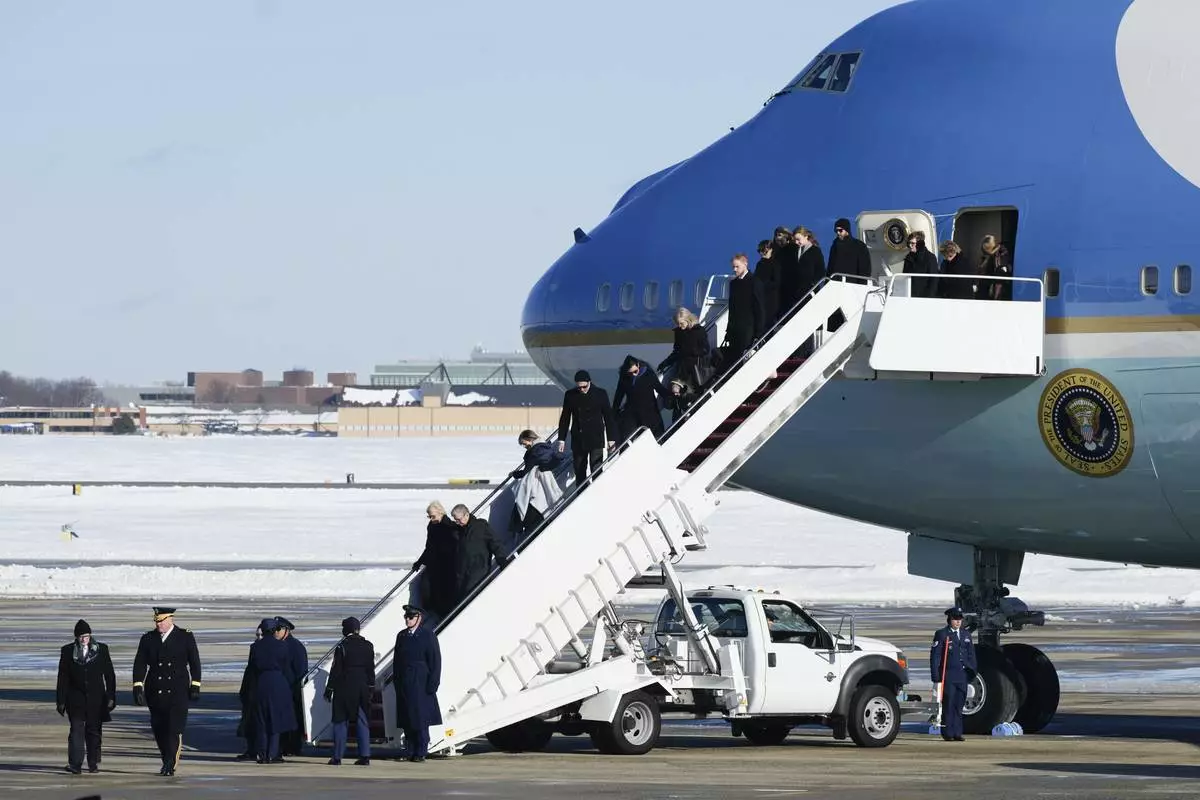
Carter family and others, walk off a military plane carrying the casket of former President Jimmy Carter, as they arrive at Joint Base Andrews, Md., Tuesday, Jan. 7, 2025. (AP Photo/Steve Helber)
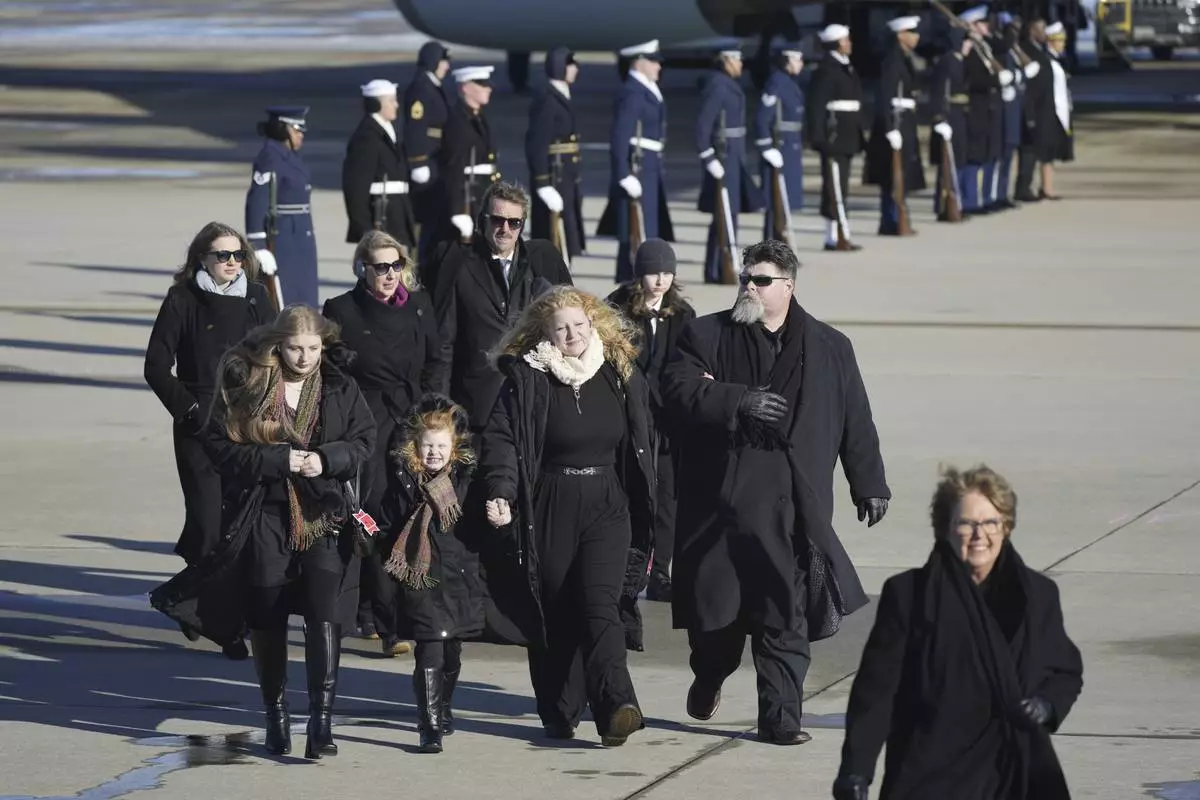
The Carter family walks off a military plane carrying the casket of former President Jimmy Carter, as they arrive at Joint Base Andrews, Md., Tuesday, Jan. 7, 2025. (AP Photo/Steve Helber)
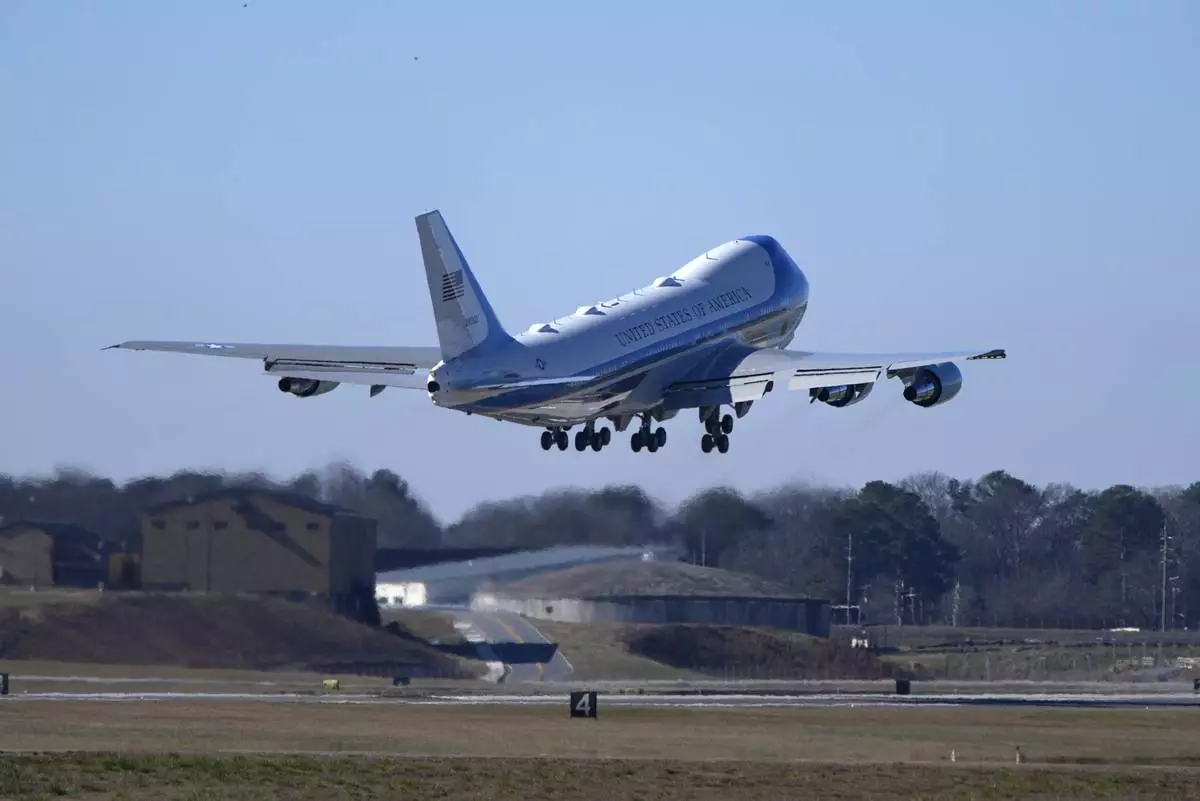
Special Air Mission 39, carrying the flag-draped casket of former President Jimmy Carter, departs Dobbins Air Reserve Base in Marietta, Ga., Tuesday, Jan. 7, 2025, en route to Washington. Carter died Dec. 29 at the age of 100. (AP Photo/Alex Brandon, Pool)
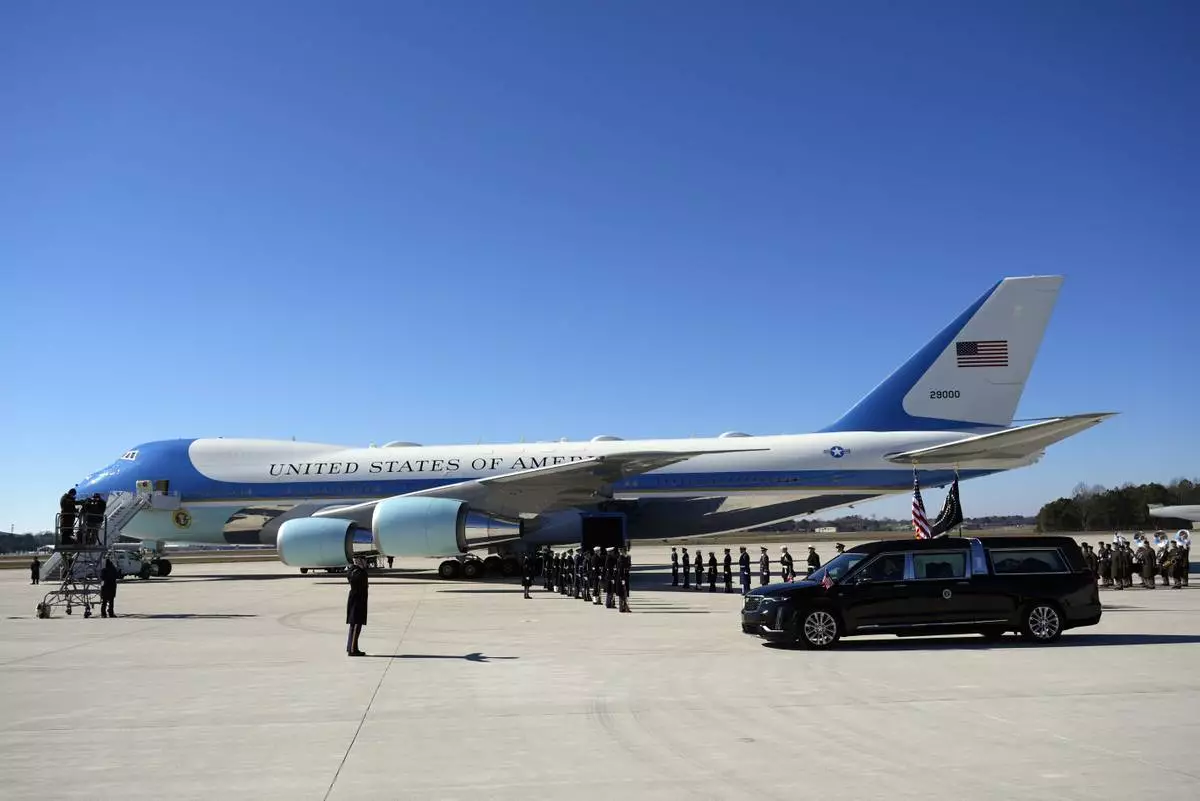
The hearse carrying flag-draped casket of former President Jimmy Carter arrives at Dobbins Air Reserve Base in Marietta, Ga., Tuesday, Jan. 7, 2025. Carter died Dec. 29 at the age of 100. (AP Photo/Alex Brandon, Pool)
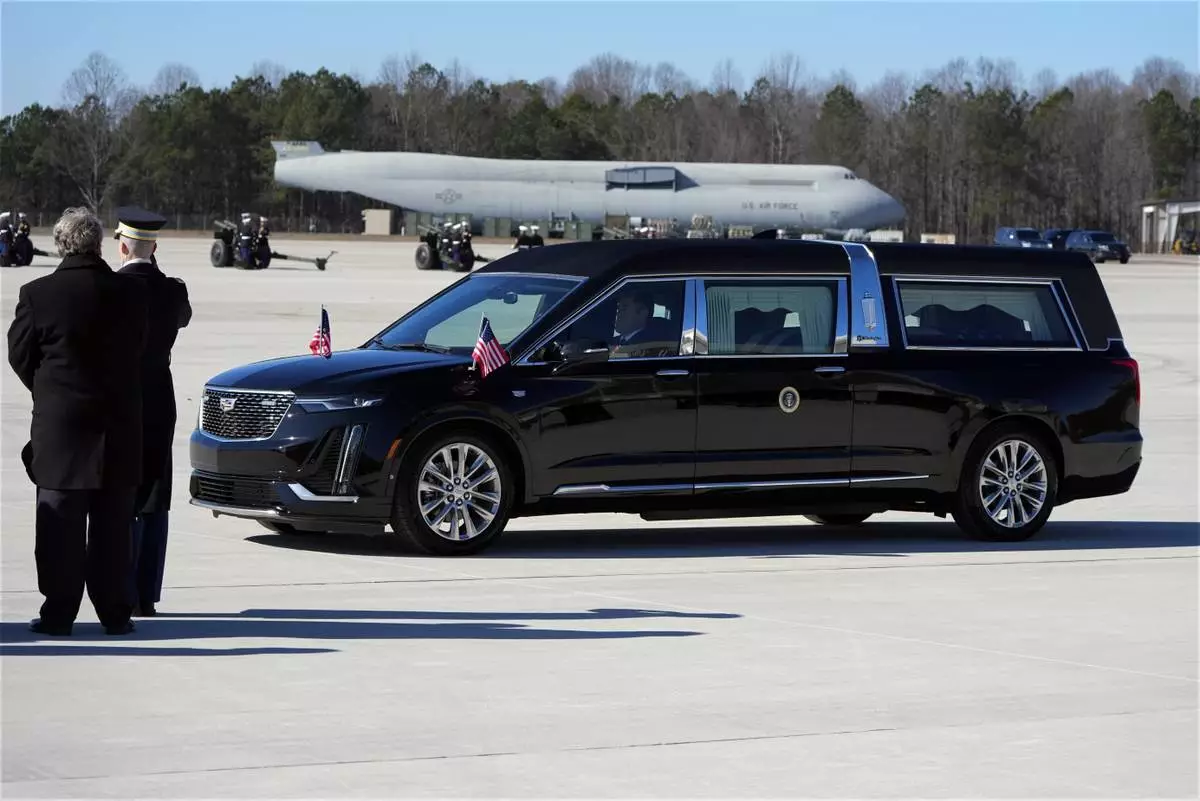
The hearse carrying the flag-draped casket of former President Jimmy Carter arrives at Dobbins Air Reserve Base in Marietta, Ga., Tuesday, Jan. 7, 2025. Carter died Dec. 29 at the age of 100. (AP Photo/Alex Brandon, Pool)
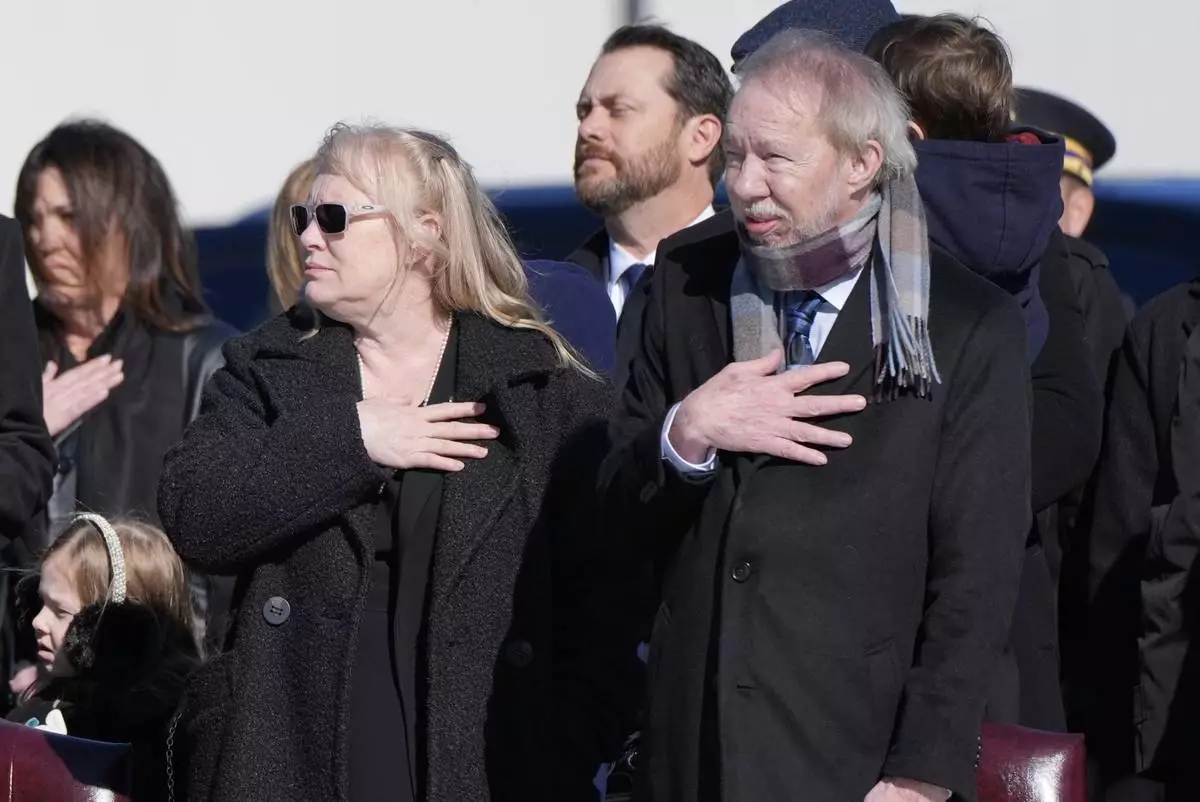
Amy Carter and Jeff Carter watch as the flag-draped casket of former President Jimmy Carter is placed on Special Air Mission 39 at Dobbins Air Reserve Base in Marietta, Ga., Tuesday, Jan. 7, 2025. Carter died Dec. 29 at the age of 100. (AP Photo/Alex Brandon, Pool)
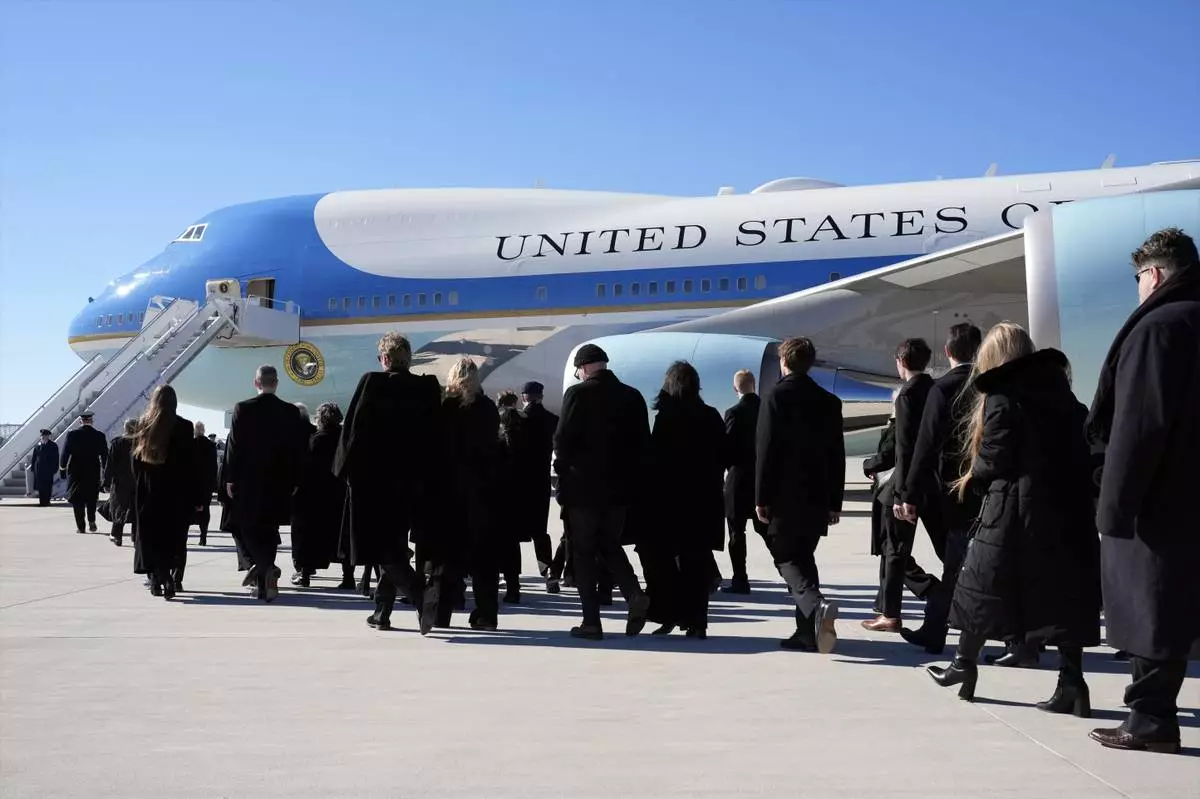
Family members walk to board the plane after the flag-draped casket of former President Jimmy Carter was placed on Special Air Mission 39 at Dobbins Air Reserve Base in Marietta, Ga., Tuesday, Jan. 7, 2025. Carter died Dec. 29 at the age of 100. (AP Photo/Alex Brandon, Pool)

A joint forces military body bearer team moves flag-draped casket of former President Jimmy Carter to Special Air Mission 39 at Dobbins Air Reserve Base in Marietta, Ga., Tuesday, Jan. 7, 2025. Carter died Dec. 29 at the age of 100. (AP Photo/Alex Brandon, Pool)
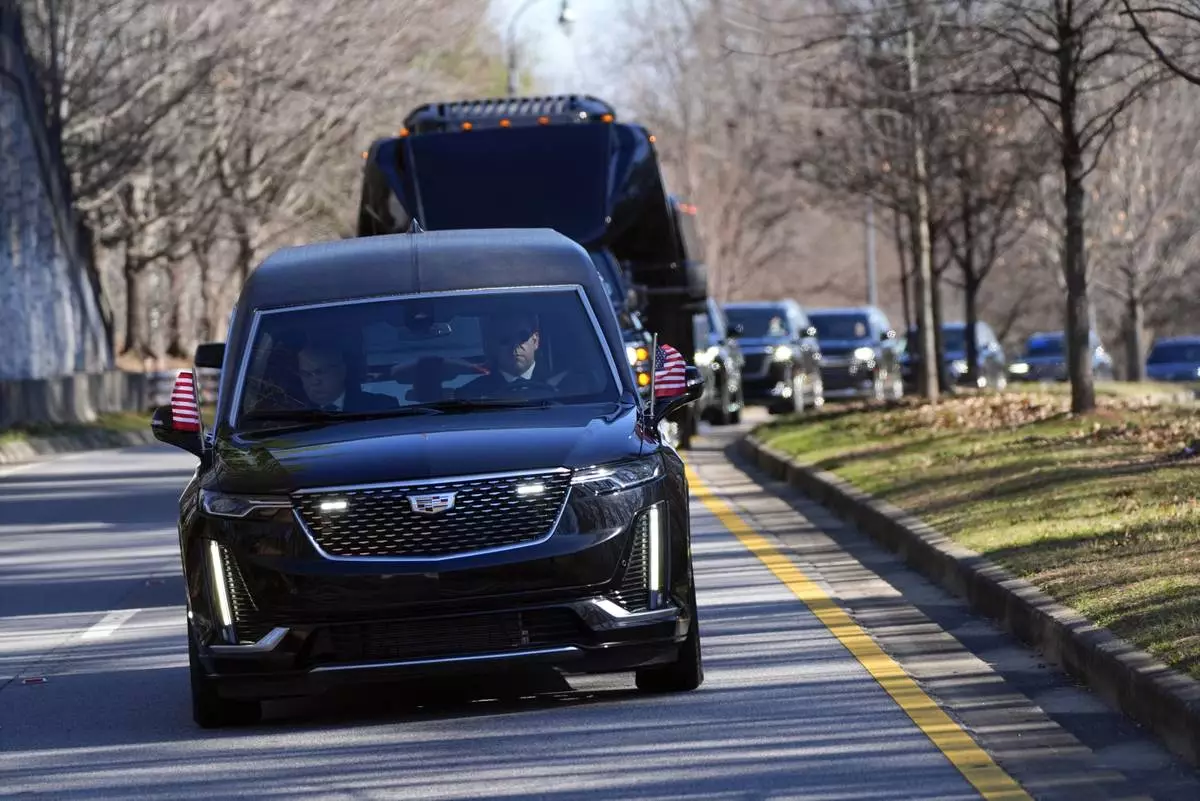
The motorcade carrying the casket of former President Jimmy Carter departs the Jimmy Carter Presidential Library and Museum in Atlanta, Tuesday, Jan. 7, 2025. Carter died Dec. 29 at the age of 100. (AP Photo/Alex Brandon, Pool)

The casket of former President Jimmy Carter is carried by a joint services body bearer team from the Jimmy Carter Presidential Library and Museum in Atlanta, Tuesday, Jan. 7, 2025. Carter died Dec. 29 at the age of 100. (AP Photo/Alex Brandon, Pool)
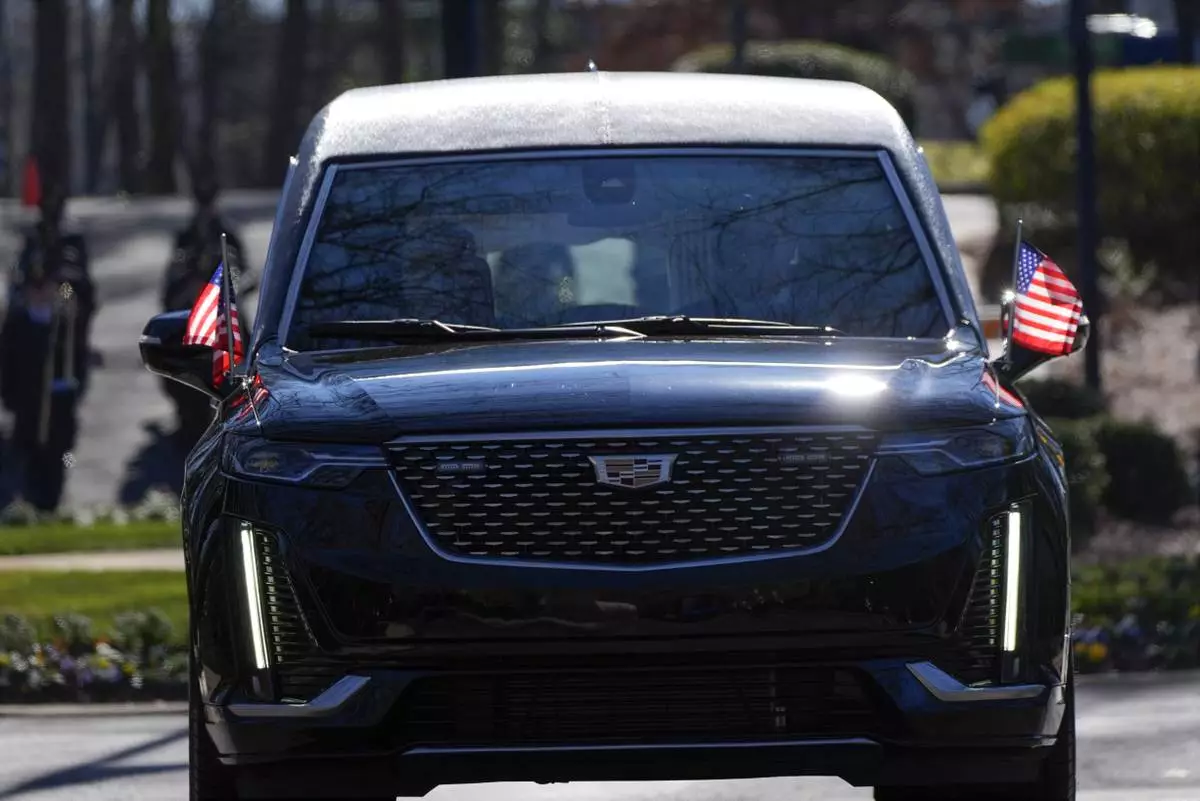
The hearse carrying the casket of former President Jimmy Carter departs the Jimmy Carter Presidential Library and Museum in Atlanta, Tuesday, Jan. 7, 2025. Carter died Dec. 29 at the age of 100. (AP Photo/Alex Brandon, Pool)

The casket of former President Jimmy Carter is placed into the hearse by a joint services body bearer team from the Jimmy Carter Presidential Library and Museum in Atlanta, Tuesday, Jan. 7, 2025. Carter died Dec. 29 at the age of 100. (AP Photo/Alex Brandon, Pool)
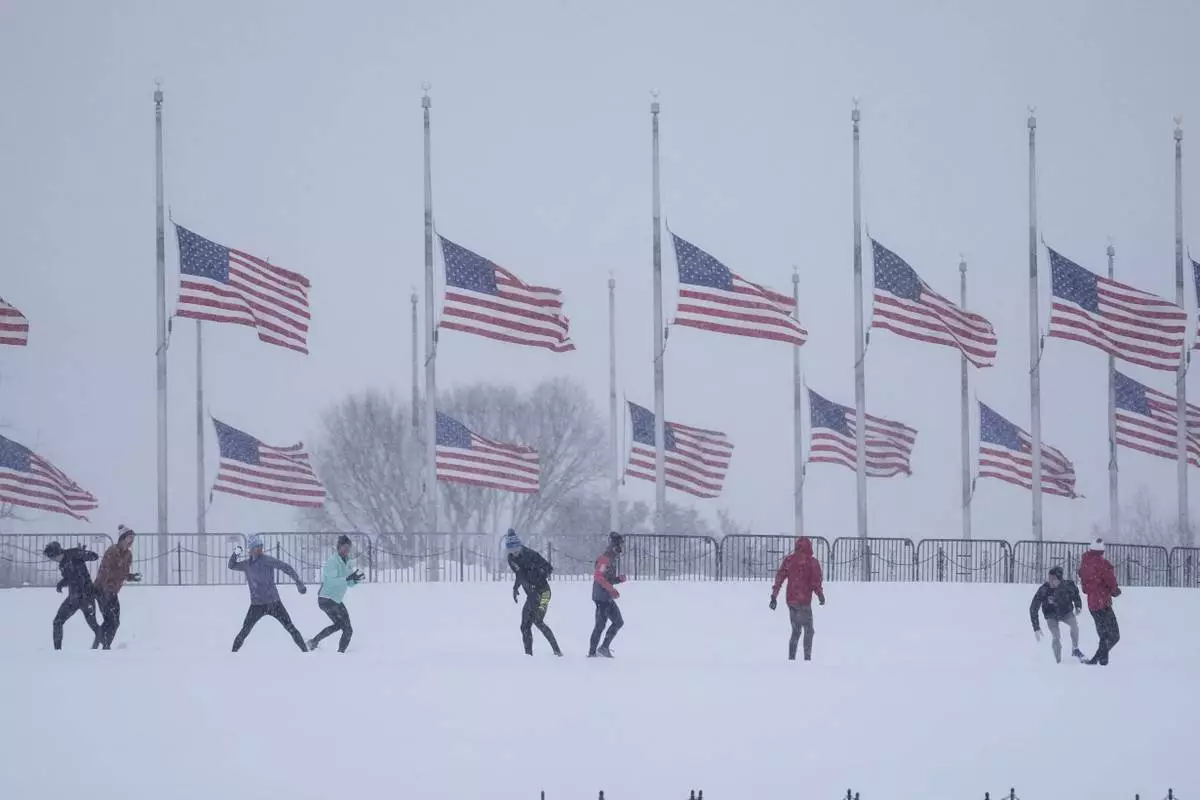
People engage in a snowball fight as U.S. flags, along the base of the Washington Monument, fly at half-staff in memorial to former President Jimmy Carter, who died at the age of 100, in Washington, Monday, Jan. 6, 2025. (AP Photo/Matt Rourke)
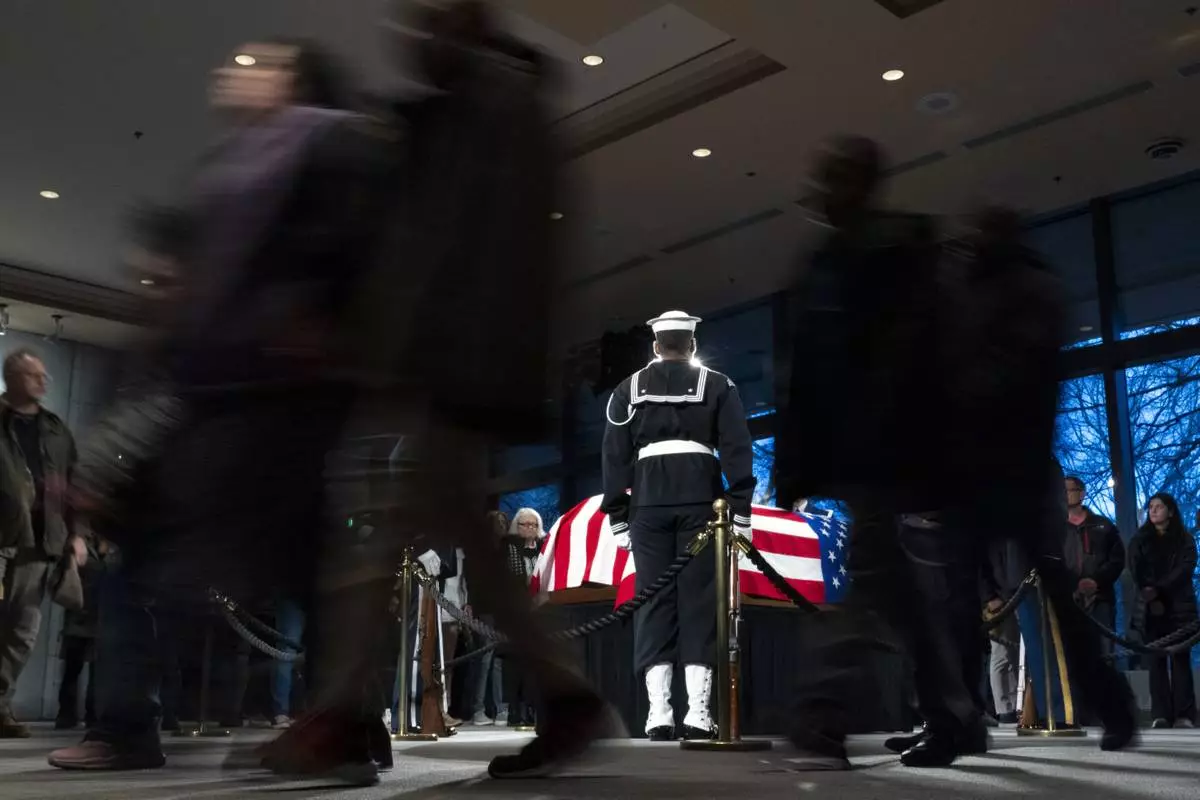
Mourners view the casket of former President Jimmy Carter as he lies in repose at the Jimmy Carter Presidential Library and Museum in Atlanta, Sunday, Jan. 5, 2025. Carter died Dec. 29 at the age of 100. (AP Photo/Alex Brandon, Pool)
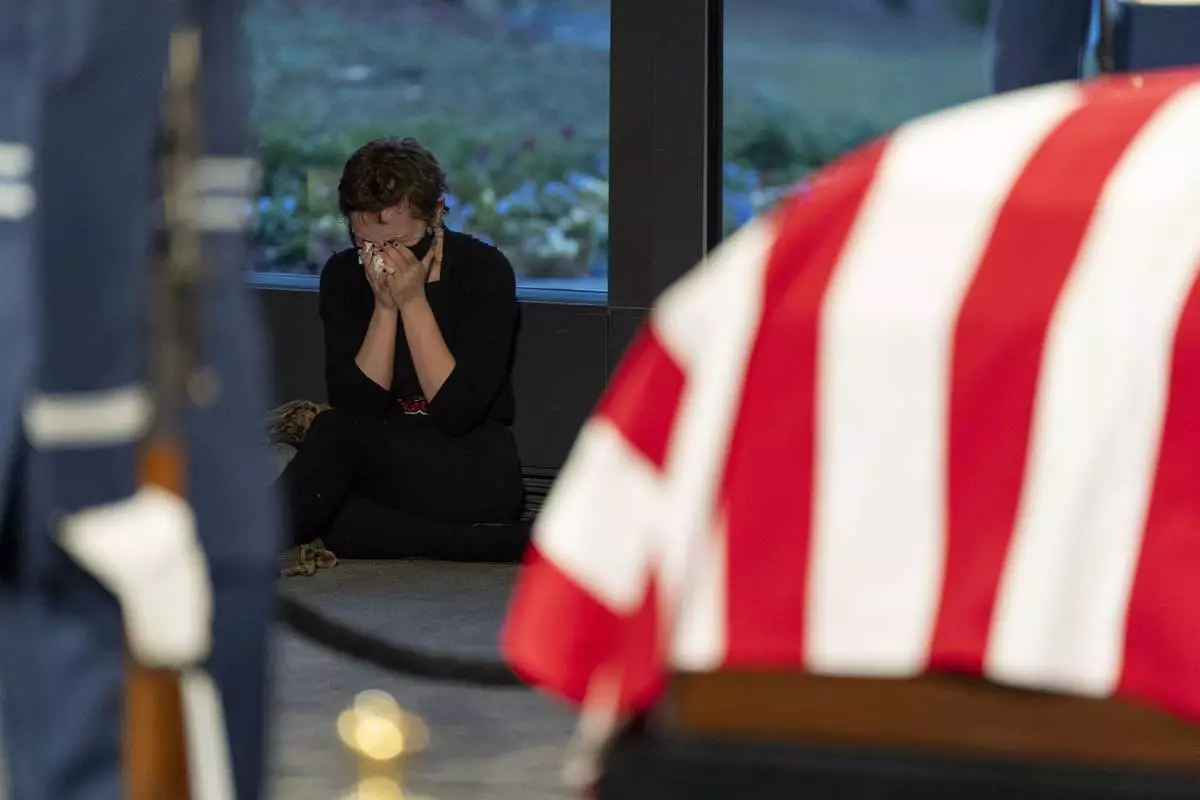
Annabeth Mellon becomes emotional while viewing the casket of former President Jimmy Carter as he lies in repose at the Jimmy Carter Presidential Library and Museum in Atlanta, Monday, Jan. 6, 2025. Carter died Dec. 29 at the age of 100. (AP Photo/Alex Brandon, Pool)

Mourners hold remembrance cards as they view the casket of former President Jimmy Carter as he lies in repose at the Jimmy Carter Presidential Library and Museum in Atlanta, Monday, Jan. 6, 2025. Carter died Dec. 29 at the age of 100. (Erik S. Lesser/Pool via AP)
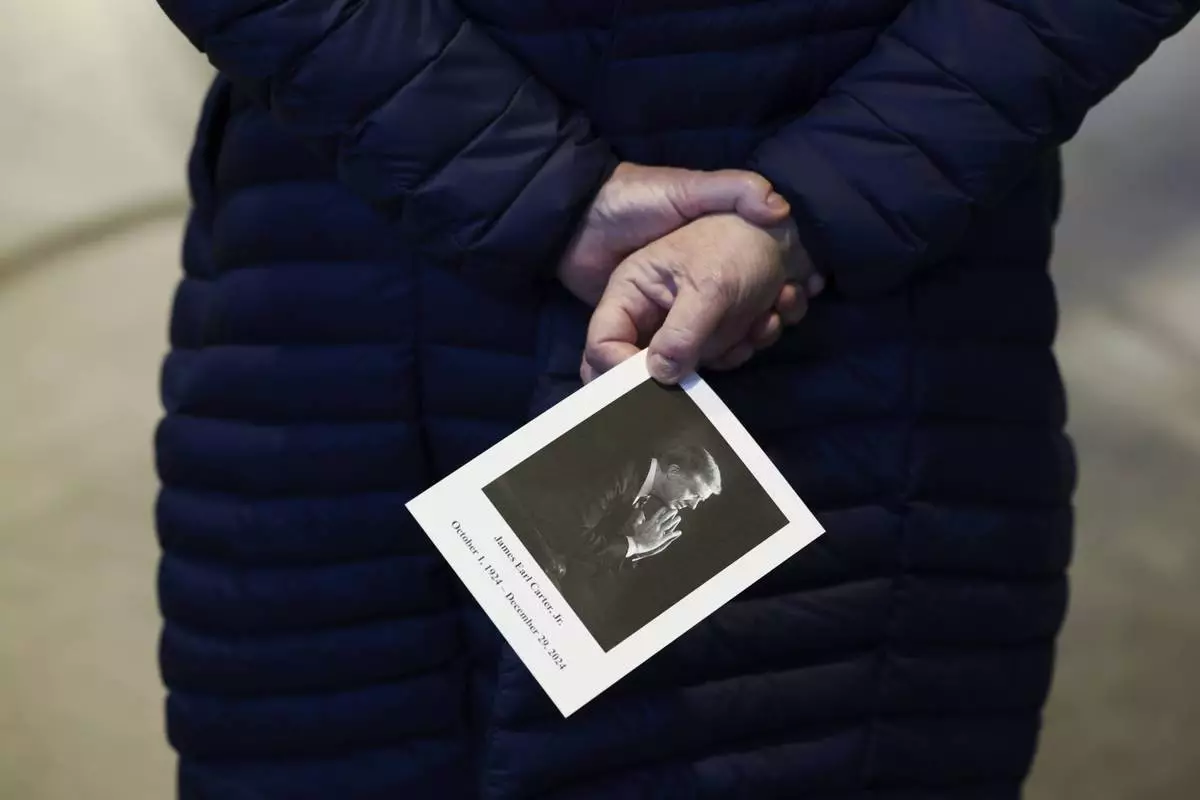
A mourner carries a picture of former President Jimmy Carter as she stands near his casket as he lies in repose at the Jimmy Carter Presidential Library and Museum in Atlanta, Monday, Jan. 6, 2025. Carter died Dec. 29 at the age of 100. (Joe Raedle/Pool via AP)

The joint services military honor guard stand around the casket of former President Jimmy Carter as he lies in repose at the Jimmy Carter Presidential Library and Museum in Atlanta, Tuesday, Jan. 7, 2025. Carter died Dec. 29 at the age of 100. (AP Photo/Alex Brandon, Pool)

Mourners view the changing of guard of the joint services military honor guard as the casket of former President Jimmy Carter as he lies in repose at the Jimmy Carter Presidential Library and Museum in Atlanta, Tuesday, Jan. 7, 2025. Carter died Dec. 29 at the age of 100. (AP Photo/Alex Brandon, Pool)










































